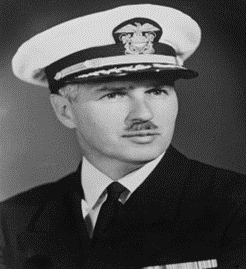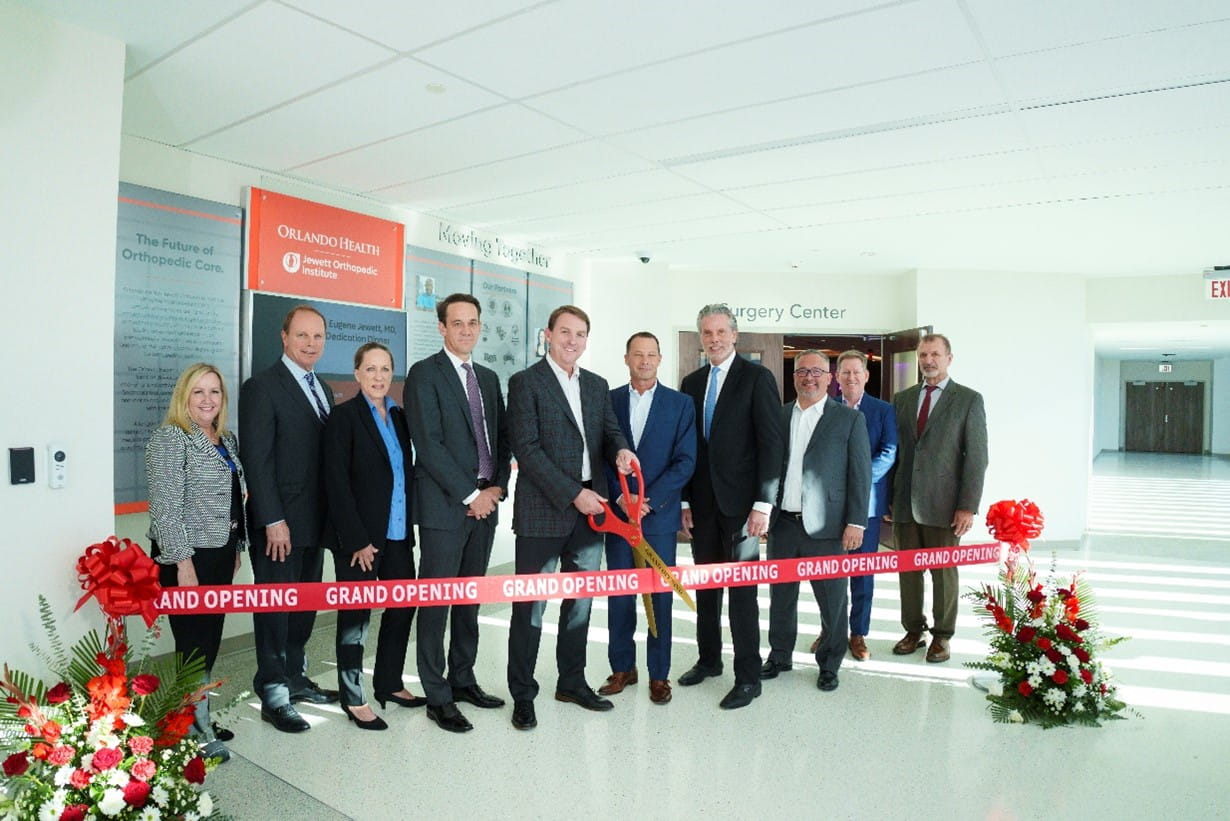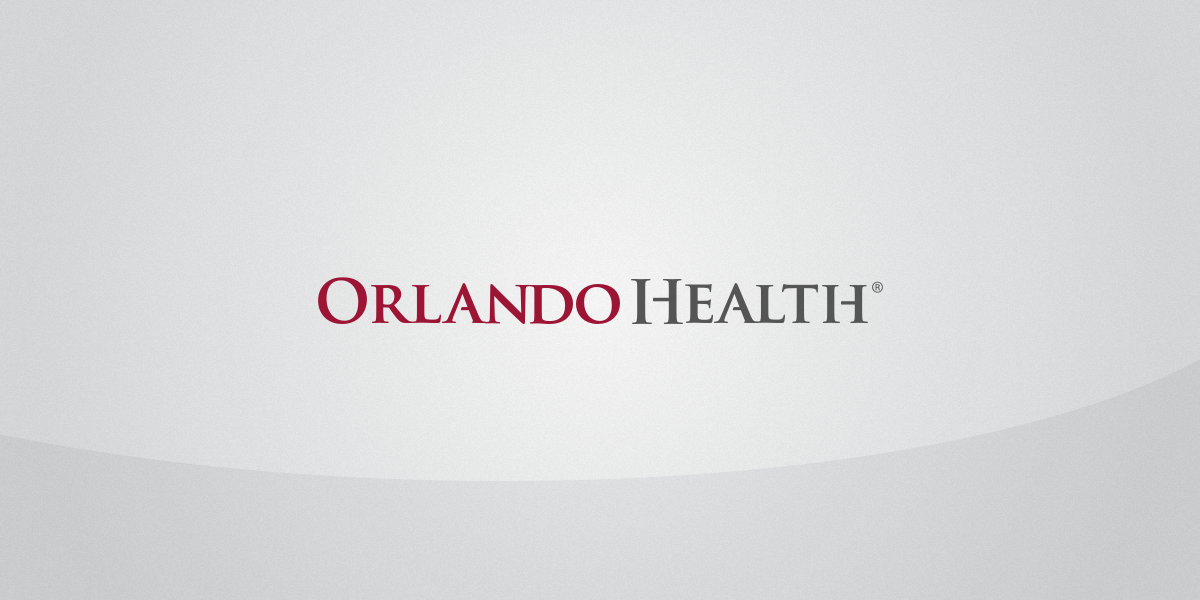Orlando Health Jewett Orthopedic Institute Begins Welcoming Patients
Leaders pay tribute to orthopedic medicine pioneer who inspired project
Orlando, FL (March 27, 2023) – A man in white lab coat stands with a woman in a white dress and starched nurse’s cap on her head in the hot Florida sun. They bend over the trunk of a dusty car that is all bulbous fenders and chrome bumpers. Carefully they lift the heavy lead-lined components of one of the latest scientific miracles out of the vehicle and onto a small cart.
Squinting at the grove house and the porch where the owner tripped and fell six weeks ago, the doctor notes with relief that a black wire as thick as his thumb slopes from a tall wooden pole at the edge of the dirt road to the side of the house. There is electricity to power the machine. Most of Orlando, where he has his office, has had electricity in its houses and businesses for years, but miles out into orange and cattle country in the middle of the Great Depression, electricity is rare for many. Even more rare – in fact, until now it has been unheard of – is a doctor toting an x-ray machine to a patient’s home.
The year is 1936 and Eugene Jewett M.D. has already changed the practice of orthopedic medicine in Central Florida, he is about to change it for the world.
The Orlando Health Jewett Orthopedic Institute Downtown Complex
Flash forward 87 years to March 2023 and the opening of the Orlando Health Jewett Orthopedic Institute, a 375,000-square-foot facility at the corner of Lucerne Terrace and Columbia Street in downtown Orlando that is expected to become the leading orthopedic center for excellence in the Southeast. Named for Dr. Jewett and the respected orthopedic clinic that he founded, the new facility seeks to continue the legacy of innovation and selfless devotion to medical advancement that characterized Dr. Jewett’s astounding life.

Phase one, which includes the Eugene Jewett, MD Surgery Center opens March 27. Dr. Jewett would be amazed by the technology in the facility. Far from the clunky portable X-ray machine he dragged into rural Florida, today’s surgeons will have access to 12 operating rooms and imaging services like an ultrafast MRI with augmented reality. A 62-exam room clinic will offer walk-in orthopedic care and there is a physical therapy space featuring sports simulators for athletes.
A second phase of the project will be complete in August, featuring the state’s first orthopedic hospital with 10 additional operating rooms, 75 inpatient smart rooms and a bioskills lab.
“Back in the 1930s and 40s, broken hips and spinal fractures were more feared than cancer. If you fell and broke your hip it was often a grave prognosis,” said Michael Jablonski, M.D., Physician President of the Orlando Health Jewett Orthopedic Institute. And a long a painful death it could be. The standard practice for a severe leg or hip fracture was to put the patient in bed with their leg immobilized by pins in the bones and suspended by a kind of winch at the foot-end of the bed that would stretch and elevate the limb. They could be in this position for months, waiting for the bones to knit back together. In addition to the discomfort and feelings of claustrophobia, patients’ muscles would atrophy, and they often developed bedsores, infections, and pneumonia. The mortality rate for a hip fracture was very high, indeed.
Dr. Jewett invented a solution: The Jewett Hip Nail – an L-shaped steel rod that a surgeon could use to permanently repair the broken bone almost immediately. Because thigh (femur) bones are essentially hollow, the surgeon could screw the rod into the top of the femur and attach it to the ball-shaped bone inside the hip socket. It was a revolutionary change that not only improved the quality of patients’ lives, but it also literally saved their lives.
“I mean no exaggeration; it saved hundreds of thousands if not millions of lives,” said Dr. Jablonski. “The reason it’s so important is that it allows people to get up and move the same day of surgery. You can get up, move and ambulate right away, and heal that much faster.”
By the early 1940s, Dr. Jewett was routinely using his hip nail on patients and was recognized as one of the leading proponents of the technique. Soon, doctors around the world were using the Jewett Nail or similar devices.
Spinal injuries presented a similar problem. When someone fractured their spine, they were usually placed into a full-body cast, which immobilized the patient.

So, Dr. Jewett developed the Jewett Hyperextension Back Brace. Made of flat steel bars, straps and pads, the brace immobilized the spine, but it was much lighter than a heavy plaster-of-paris cast, allowed the patient greater mobility and personal hygiene, and it could be removed and adjusted if necessary.
These inventions not only made Dr. Jewett famous, they made him and his wife Ruth, also a physician and specialist in cardiology, wealthy. That is, the inventions could have made them wealthy except the childless couple decided to direct the income from the inventions back into medical science and into education for others.
The story of the Jewetts contains so much more than just the inventions, and Dr. Jablonski and his colleagues at the Orlando Health Jewett Orthopedic Institute hope the story continues to be a touchstone and inspiration for all the physicians and other professionals who practice and learn at the new center. Research will be a big part of the new institute. A research and education center will include a 10-station cadaver lab and 3D printer, as well as a 116-seat auditorium for learning opportunities.
Dr. Jewett’s Journey to Orthopedic Medicine
Before he stood before that grove house as a doctor who made house calls with a portable X-Ray machine, before he invented the hip nail and the back brace, before he came to Florida in the middle of the Great Depression, before all that, Dr. Jewett was a chemist. And he was bored.
Born in Freedonia, NY, at the turn of the last century, he earned a degree in chemistry and engineering from the prestigious Cornell University. Getting a job in this field came easily, but he found the work tedious and uninspiring.
"For one year I had been watching the clock on the wall," he told a newspaper reporter. "I said if I'm going to get into anything where I'm watching the clock, I'm in the wrong business." He decided to become a doctor, and his whole family pitched in to help with the expenses.
He earned admission to Harvard University’s medical school and began a career that would become his all-consuming passion.
Dr. Jewett began his practice in New York but soon was in Orlando to seek remedies for his own ailing health.
"I had begun having terrific sinus attacks with streptococcus throat," he said. "That was before the days of sulfa and antihistamines. I had also developed arthritis in my hands, and I was having trouble operating. I decided to give it up. I came down here, liked the warm, moist climate. I had a chance to sail a lot and play tennis, and after a year I got over this thing and continued with my practice."
Dr. Jewett’s Legacy
After gaining recognition for his home visits, hospitals began seeking him out. They would assemble rooms full of orthopedic patients for him to examine and treat. Not only would he treat patients, but he would help teach other doctors in new ways to treat their patients.
After World War II broke out in 1941, Dr. Jewett volunteered for military service and was assigned aboard the U.S. Navy Hospital Ship USS Good Samaritan. He wore the rank of captain and was made the Chief of Orthopedics and Chief of Surgery. And during his service, he was awarded four Bronze Star medals for bravery in action. Back in Florida after the war, “Dr. Gene,” as he was called, continued visiting hospitals throughout the state seeking to elevate their orthopedic care. When he died, he was affiliated with 12 different institutions.
In 1950, the Jewetts gave $150,000, nearly $2 million in today’s currency, to help found a hospital in Winter Park. “That was a lot of money,” said Dr. Jablonski. “And he donated it because it was his belief that patients did better, had better outcomes, if they could be treated and recover closer to home.”
It was also during the early 1950s that Gene and Ruth Jewett began visiting South America and fell in love with the cultures and people. During one of their visits, they discovered that many South American doctors were seeking fellowships or research opportunities in the United States to further their knowledge of orthopedic medicine. Unfortunately, the larger medical education foundations were not meeting this need. So, the Jewetts did again what they had so often done in the past when they observed a need. They stepped in to fill it. They established the Jewett Foundation, using funds received from the inventions. The foundation enabled physicians from Colombia and many other nations to advance their knowledge in America. It also helped provide for treatment of children in need of orthopedic medicine.
By the 1970s, the group practice that Dr. Gene had founded, the Jewett Orthopaedic Clinic, became one of the leading centers for orthopedic surgery in the United States and in the early 1970s, the Jewett team performed several of Florida first-in-state surgeries including the first total hip replacement and the first Anterior Cruciate Ligament (ACL) reconstruction.
It was at this time that a young surgeon named John McCutchen, MD, left one of the nation’s leading orthopedic centers to join the Jewett team. Although he had retired from treating patients, Dr. Gene was part of the group of physicians who interviewed, discussed medicine and socialized with Dr. McCutchen over several days.
“Dr. Jewett was a slight man, very humble and very disciplined. And his wife, Ruth, was a cardiologist and very fun and would often start an event by telling a joke,” said Dr. McCutchen.
There was never any doubt in his mind, Dr. McCutchen said, about joining the Jewett team. It was not only the best orthopaedic clinic in the country, it was internationally renowned. When he applied to a fellowship program in Milan, Italy, in the early 1980s, Dr. McCutchen said the Jewett reputation established immediate credibility with the physicians he contacted. “That paved my way,” he said.
In 1982, Ruth Jewett died, and Dr. Gene decided to give his assets, including his home, to the University of Florida’s school of medicine in exchange for a small annuity. He continued to live aboard his houseboat for the next five years until he too died in 1987. In a final act of devotion to medical science, the Jewetts had even donated their bodies to the University of Florida medical school for study by the students. By the end of their lives, they had literally given everything they possessed to advance medical knowledge.
It’s an extraordinary ending to a life and a professional career that began out of frustration with one field only to be filled with a monumental passion and level of devotion that may be hard for some to imagine. But it is that overwhelming desire – a need really – to improve patients’ lives that Dr. Jablonski and the leadership team at the new Orlando Health Jewett Orthopedic Institute hope will live on.
Now retired from medical practice, Dr. McCutchen reflected on the importance of the Jewett name and legacy as it applies to the new center. “It might sound like a cliché,” Dr. McCutchen said. “But we truly do stand on the shoulders of giants. It is very unusual to have a clinic outlive its founder because the people who come after sometimes lose the dream. The Jewett name and memory are foundational to the Orlando Health Jewett Orthopedic Institute.”
Dr. Jablonski agreed. “It’s more than a name,” he said. “It’s a legacy that we pride ourselves on, and we try to live up to that legacy every day.”
About Orlando Health
Orlando Health, headquartered in Orlando, Florida, is a not-for-profit healthcare organization with $8.1 billion of assets under management that serves the southeastern United States.
Founded more than 100 years ago, the healthcare system is recognized around the world for Central Florida’s only pediatric and adult Level I Trauma program as well as the only state-accredited Level II Adult Trauma Center in Pinellas County. It is the home of the nation’s largest neonatal intensive care unit under one roof, the only system in the southeast to offer open fetal surgery to repair the most severe forms of spina bifida, the site of an Olympic athlete training facility and operator of one of the largest and highest performing clinically integrated networks in the region. Orlando Health has pioneered life-changing medical research and its Graduate Medical Education program hosts more than 350 residents and fellows.
The 3,238-bed system includes 23 hospitals and emergency departments – 18 of which are currently operational with five coming soon. The system also includes nine specialty institutes, more than 100 adult and pediatric primary care practices, skilled nursing facilities, an in-patient behavioral health facility under the management of Acadia Healthcare, and more than 60 outpatient facilities that include imaging and laboratory services, wound care centers, home healthcare services in partnership with LHC Group, and urgent care centers in partnership with FastMed Urgent Care. More than 4,000 physicians, representing more than 100 medical specialties and subspecialties have privileges across the Orlando Health system, which employs more than 25,000 team members and more than 1,200 physicians.
In FY22, Orlando Health served nearly 142,000 inpatients and 3.9 million outpatients. The healthcare system provided more than $782 million in total value to the communities it serves in the form of charity care, community benefit programs and services, community building activities and more in FY 21, the most recent period for which this information is available. Additional information can be found at http://www.orlandohealth.com, or follow us on LinkedIn, Facebook, Instagram and Twitter @orlandohealth.







